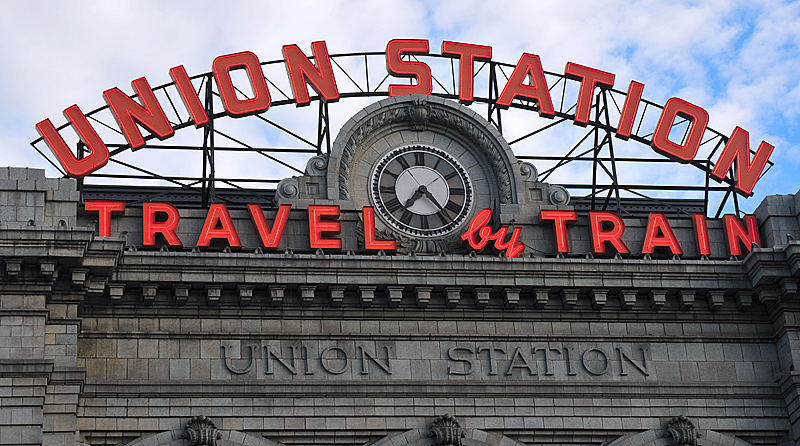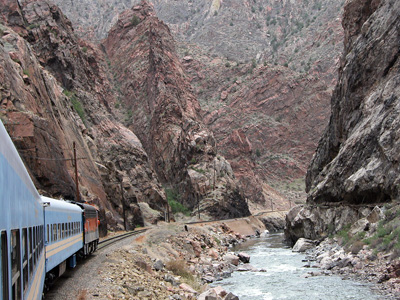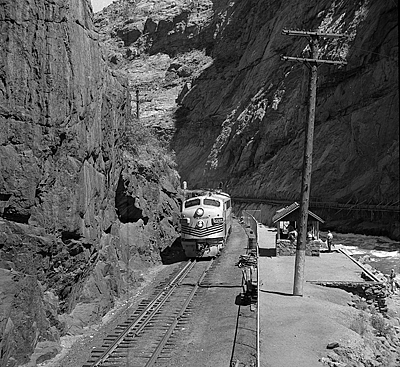






Canon City, Colorado -- All is quiet and peaceful as the little train clicks and clacks along the bank of the Arkansas River and gradually enters the great, dark canyon. It is a fine Rocky Mountain spring day and still not yet very green, but cholla cactus bloom bright yellow along the tracks. A hawk soars far overhead, while, below, the river flows heavily with spring runoff. No highway invades this gorge. The only people we see along the line are riding rafts or kayaks down the Arkansas River or enjoying a bit of fly fishing after a long hike. But it wasn't always this quiet and peaceful: this is the site of, "The Royal Gorge War". Major historical events with far reaching significance to Colorado and the nation's transportation system happened here in the 1870s.
The old Santa Fe station now serves the Royal Gorge Route
The little blue and white train climbs steadily upstream while the canyon walls seem to grow higher and closer. Well inside the canyon, a fragile looking suspension bridge comes into view high above our train. Its span is 1,260 feet across the canyon. From the unobstructed view of an open railroad car, we can actually see light between the wooden boards that form the deck of the bridge. This is the Royal Gorge Suspension Bridge 1,053 feet above. It was completed in 1929 and actually doesn't go anywhere.
Vintage F7 diesels power the train
There is a funicular railway here that brings people down from the top. Its tracks descend at a 45 degree angle with two cars balancing each other -- one goes up while the other goes down. An Alpine like cable car is also visible spanning the canyon near its top. All these attractions are at the Royal Gorge Bridge and Park which has been one of Colorado's most popular tourist destinations for over 75 years.
Entering the canyon
Beneath the suspension bridge, the walls are so close together and so steep that a place to build railroad tracks seemed impossible. The surging river simply must occupy the entire canyon bottom. But in 1879 a "hanging bridge" was devised and built to allow the tracks to pass through the narrow space suspended above the rushing water. This bridge still serves the railway today.

Headed down the canyon with F7 power
Further up the tracks, towards Parkdale, the gorge starts to open up a little. It is along here that little placements of rocks can be seen above the tracks on the canyon walls. At least seventeen of them have been identified. Old photographs show these rock forts bristling with men and rifles defending the canyon.
Open cars allow for an excellent view
This wasn't a skirmish of the Civil War; this was a war for territory between two competing railroads: Colorado's own "baby road," the Denver & Rio Grande, a small, local narrow gauge line, and the big, standard gauge, Atchison Topeka & Santa Fe. Many of the men involved, however, were soldiers in the then recent, bloody war: notably D&RG's president, General William Jackson Palmer.
The best view of the Hanging Bridge is from an open car
In February of 1878, the Santa Fe had grabbed Raton Pass from the D&RG mere hours before crews were to start their surveys of that route. Just two months later, with the rich prospects of the Leadville mining boom daily in the news, the Santa Fe was attempting to do it all over again along the Arkansas River canyon.
The Santa Fe's Canon City & San Juan seized the entrance to the canyon west of Canon City cutting off the D&RG's survey party for the second time. Clearly, there was barely enough room for the tracks of one railroad - certainly not for two. The outraged Rio Grande established a deadline in the canyon and built forts upstream to enforce it. Both railroads recruited men well accustomed to the use of firearms: the Santa Fe brought in Bat Masterson with a crew of men from Dodge City. The resulting standoff was widely known as, "The Royal Gorge War".
Financial difficulties forced the D&RG to lease their lines to the Santa Fe, but it was soon apparent that the Santa Fe was routing freight over their own longer lines to the detriment of Rio Grande profits. A court order was obtained terminating the lease, and in a military style sweep, the D&RG retook control of their railroad.
Fortunately, though, the battles of this war were mainly fought in the courts, eventually reaching all the way to the U. S. Supreme Court. The final agreement provided that the AT&SF would retain Raton Pass while the D&RG would take possession of the Royal Gorge route.
The Denver & Rio Grande was originally projected as a north south railroad with branches into the mountains, but all the conflicts forced a major reconsideration of destinations. The D&RG eventually evolved as an east west route with its main line between Denver and Salt Lake City. In later years, railroad advertising referred to the Denver & Rio Grande as, "The Royal Gorge Route", while the Santa Fe was known as, "The Grand Canyon Route".
For many years afterward, the Royal Gorge was one of the most scenic of several alternate transcontinental railway routes across the American west. Once the domain of such suggestively named trains as The Scenic Limited and The Panoramic, regular passenger service here ended July 27, 1967. The last regular passenger trains were Denver & Rio Grande Western (the Western was added in later years) east bound Train 1 and west bound Train 2 proudly named, "The Royal Gorge".
The Royal Gorge suspension bridge comes into view.
My own memories of the Royal Gorge railroad go back to 1958 when I photographed a train at the bottom of the gorge. Denver & Rio Grande Western's Train Number 1, The Royal Gorge, arrived and stopped just beyond the hanging bridge. It was a long standing tradition on the D&RGW to stop all passenger trains there so that passengers might get off and enjoy the exceptional view. A special concrete platform was provided.

Westbound D&RGW Train 1, The Royal Gorge, arriving at the hanging bridge – June 24, 1958
Since the 1870s much has changed in the canyon: men and railroad companies have come and gone, but the canyon has hardly changed at all. The railroad is no longer a major rail corridor, but in 1999, trains of a new operator, The Royal Gorge Route Railroad, renewed passenger service. Today's trains travel twelve miles through the canyon as far as Parkdale and return to Canon City two hours later. The railroad operates year around (except for January) with more departures available during the summer peak season. Classes of service available include basic coach class, dome observation class and various dining car options. Except aboard the special murder mystery, dinner trains, all is quiet and peaceful along the line, and the scenery is still as grand as ever.
More Information
Trains of the Royal Gorge Route begin the operating year with weekend schedules starting in February. Daily trains begin in May and end in October with as many as four departure times a day. Weekend schedules continue through December except for Christmas Eve and New Years Eve.
Royal gorge Route Railroad